-
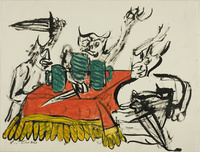 Demons Seated at a Table
Demons Seated at a Table This commission explain Orozco idea of people with higher power. As peasants are struggling to fight and survive. The "demons" (richer people) are sitting at a table and not worrying about anything or anyone other then themselves..
-
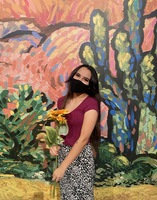 Adrianna Sharp
Adrianna Sharp
-
 José Clemente Orozco
José Clemente Orozco The commission is an image of the artist, José Clemente Orozco.
-
 Weaving
Weaving This commissions is used to challenge social and political iniquities. Weaving is an old tradition, using a back- strap loom. The women, is a well known weaver named Luz Jiménez. She apprise ro be creating a pattern of blue, red, white and balk. The weaver takes the action of greater significant and dignity.
-
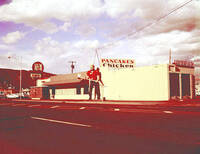 Lumberjack Cafe, Sitgreaves St. (Route 66)
Lumberjack Cafe, Sitgreaves St. (Route 66) The image shows the Lumberjack cafe. This cafe was a huge hit and everyone would eat and take picture there. In front of the cafe was a statue of a lumberjack, which was given to Northern Arizona University later on. However over time, it was sold and now it the Granny's Closet.
-
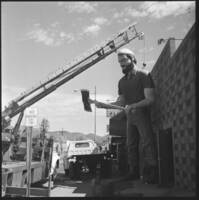 Lumberjack Statue #1 Being Moved
Lumberjack Statue #1 Being Moved This lumberjack statues if the first one of two, these is used a s a mascot for Northern Arizona University. The statues is made up if fiberglass around 1963 and was sold to the lumberjack cafe. However, later on it was sold to NAu. These statues stand by the lumberjack stadium until NAU moved them to their current location.
-
 In the Sunlight
In the Sunlight This commission describes the daily life of two women. They can be seen sitting down; looking or intrigued by something. The girls expression seem different from one another. The one on the left seems sad and tired, while the one on the right to seems happy and glad. They seem to be taking a break and enjoying the sunlight.
-
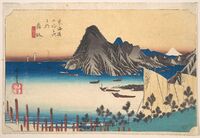 View of Imaki Point From Maizaka
View of Imaki Point From Maizaka This commission is a woodcut printing that is associated with the floating world. This image describes and tell the story of people from the Edo period. It shows people riding in their boat/canone, which they are using to collect fish. This image shows the beauty go Imaki Point from a certain view. This view is able to capture the lives of working city with a beautiful landscape.
-
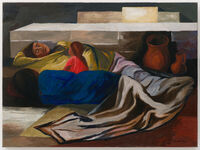 Sleeping (the Family)
Sleeping (the Family) This image shows the struggle of a Mexican family. The women are sleeping on the floor, indicating that they don't have a bed. The many blankets and long layers indicate that that's the only thing keeping them warm. The child is looking at the sleeping women. However, the women seem exhausted like she is tired from working or maintaining the house and kids. There does not seem to be many pots or house appliances around them, showing they don't have money to afford them. They are barely keeping afloat; the two pots show they are poor but still trying their best to live.
-
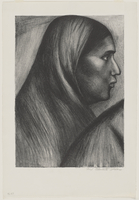 Head of a Woman
Head of a Woman The image shows the side profile of a Mexican woman. It only displays her right side of her face. It can be inferred that she is keeping a strong face by showing her right side, since the left indicated her emotional side. Her hair is covered in a shawl. She is either religious or cold; the shawl looks like hair as well. It seems a close of a specific person in a march of other people.
-
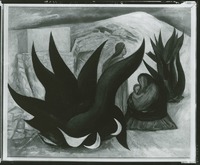 Maguey, painting
Maguey, painting The photograph of the painting is used to describe the lives of Mexican women in the struggling class . The image shows that they are sitting outside with no place for them to go. One woman is holding a baby and trying to keep it warm. While another woman is looking off in the distance, like she is waiting for something or someone. It seems they are sitting next to plants to hide or just to find cover.
-
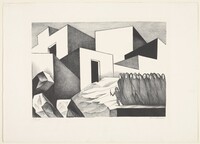 Mexican Pueblo
Mexican Pueblo The image shows women being led by a male leader. Everyone seems close together; all of them are fully clothed. However, none of these figures seem to be inside the house. They are watching the house from the outside, the house is being presented to them. It seems the women cannot afford the house so they can watch from afar. They seem close to the structures but they will never reach because of their status.
-
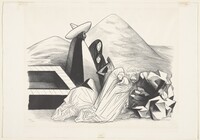 Mexican Landscape
Mexican Landscape José Orozco created this commission to display the Mexican landscape after the revolutionary war. The landscape of Mexico is known to be full of hot, dry, deserts, high mountains, and many rocks surrounding it. The commission includes a family standing outside; they're women, a man, and two children. It is unknown but is seems one of the figures have died due to the cloak covering the body. This commissions shows the hardship that families had to face after losing their homes and lands.
-
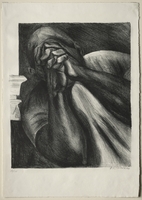 Grief ( Mural Study)
Grief ( Mural Study) José Orozco used lithograph for his commission because it showed and shared the imagery more widely. The mural focuses on the grief, the artist wants to focus on the aspect of universal emotions. He believes in the creation of a special bond for the audience. For this commission, it focuses on the emotion of grief. As one looks at the commission, the signature of the grief is the hand cupping the face. The hiding of the face can be an idea of shame, hiding, or embarrassment.
-
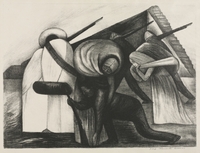 Revolution
Revolution This artwork is titled revolution to describe the life of Mexican peasant and the struggling class. This image shows the inequality and human suffering. For example, there is a man carrying what seems to be an older woman. The image shows how much Mexican people cares about their family. It shows how they will struggle and suffer to be bring anyone they love to safety and for them survive. All of the people walking, seem to be sad or distressed. This is due to the fact they have to survive from the aftermath of the revolutionary war. The commission shows individuals marching with guns and prepared to face anything that causes them trouble.
-
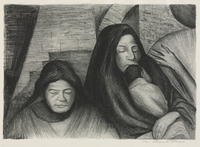 Three Generations
Three Generations This artwork shows Mexican art after the country's revolutionary war. The family of three generations shows the detailed features of a mother, child, and a grandchild. The idea of three generations shows the family connecting and being together even after hardship. This image shows the continuations of Mexican culture.
-
 Requiem
Requiem This commission describes the lives and struggles of Mexican peasants and the struggling class. It shows a group of men and women standing and sitting next to each other. Three of the people are standing, while one is kneeling and the other is sitting. The title helps further the meaning of the painting. A requiem is a mass of souls of the dead. Basically, the women and men are soul of the dead longing for a place to go. To infer the death may have been caused by their circumstances of being poor and the effects of the revolutionary war.
-
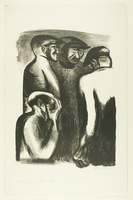 The Unemployed
The Unemployed This artwork describes the lives of men losing their job due to the war. The men look sad and hopeless, unsure of what to do now. One figure has two hands completely covering their face which shows how devastated and stresses out they are. The war caused many issues among the Mexican peasants. It caused emotional trauma and as well as loss of their daily lives. However, they still look lost and sad, having no idea what to do about their issue.
-
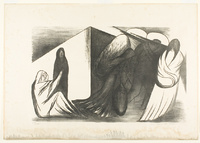 Marching Women
Marching Women This commission describes the hardship and the effects of the post- revolutionary war from the Mexican peasant's point of view. It shows men and women marching to go fight in the war. It shows how hard the family are taking it, women and child staring at their family walk away. Women and men were inspired to fight in the war. For a better future, however, the war causes a lot of trauma and damage to the families around them.
-
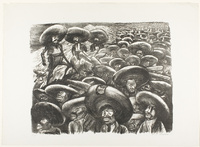 Zapatistas
Zapatistas This commission shows a crowd of men, standing and waiting for war . They are all wearing hats. The title is named Zapatista which means the national army. This image shows the army of the Mexican revolution war.
-
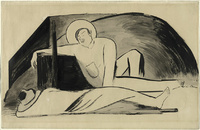 The Grave Digger
The Grave Digger The commission led to Mexican muralism. It shows the darker view of the revolution from a Mexican peasant's point of view. It shows the sacrifice of the revolution. It shows men digging up graves for the people that lost their lives in the revolution.
-
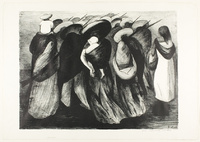 Rear Guard
Rear Guard Rear Guard is a print that shows the portion of military force. The militaries job it is to protect the rear attack. The rear guard are made of peasants, looking for work or purpose to live. The peasants were landless and working on estate or mines, they received poor treatment and not much compensation. Men and women were inspired to fight for the Mexican Revolution. They were inspired to fight because they wanted to protect their land and the future of others.
-
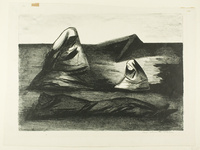 Ruined House
Ruined House The commissions shows the hardship of the Mexican life after post- revolutionary. The image includes a man, woman, and a child. They are setting outside in the open because they lost their home and farmland. The open can be described as the desert, they are sitting on dirt. Behind them can be inferred as the ruined house, only the roof can be see or it can just be a rock. They seem to have no purpose or hope, telling by the man laying faced down. They lost their identity, hitting at having no face. However, there is still hope for the child which shows some feature of their face. To sum up, it reflect the feeling of Mexican losing their live because of the affects of the post - revolutionary war.
-
 Mexican Peasants Working
Mexican Peasants Working This commission shows the hardship of the peasant life of Mexicans. It portrays them carrying items from their job. The workers (men and women) are walking in the hot and dry desert to earn money. The men and women are walking with bags or items on their back making them lean downwards. The desert it filled with cactus, plants, dirt and rocks; showing the dryness the people are walking through. They work hard job to gain an earn to stay alive, since their lives were effected by the revolution and war. This commission shows the hardship of post-revolutionary war and how hard they are trying to stay alive.
-
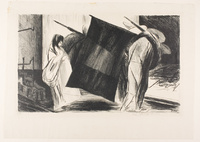 The Flag
The Flag The commission demonstrates the concept of war. It shows how emotional and devasting the impact it had on the community. It shows the flag carrying a flag, the Mexican flag. The figures are Mexican women and men, they are marching and showing pride for the country. However, due to the war the Mexican people became devastated due to its impact it had around them.
 Demons Seated at a Table This commission explain Orozco idea of people with higher power. As peasants are struggling to fight and survive. The "demons" (richer people) are sitting at a table and not worrying about anything or anyone other then themselves..
Demons Seated at a Table This commission explain Orozco idea of people with higher power. As peasants are struggling to fight and survive. The "demons" (richer people) are sitting at a table and not worrying about anything or anyone other then themselves.. Adrianna Sharp
Adrianna Sharp
 José Clemente Orozco The commission is an image of the artist, José Clemente Orozco.
José Clemente Orozco The commission is an image of the artist, José Clemente Orozco. Weaving This commissions is used to challenge social and political iniquities. Weaving is an old tradition, using a back- strap loom. The women, is a well known weaver named Luz Jiménez. She apprise ro be creating a pattern of blue, red, white and balk. The weaver takes the action of greater significant and dignity.
Weaving This commissions is used to challenge social and political iniquities. Weaving is an old tradition, using a back- strap loom. The women, is a well known weaver named Luz Jiménez. She apprise ro be creating a pattern of blue, red, white and balk. The weaver takes the action of greater significant and dignity. Lumberjack Cafe, Sitgreaves St. (Route 66) The image shows the Lumberjack cafe. This cafe was a huge hit and everyone would eat and take picture there. In front of the cafe was a statue of a lumberjack, which was given to Northern Arizona University later on. However over time, it was sold and now it the Granny's Closet.
Lumberjack Cafe, Sitgreaves St. (Route 66) The image shows the Lumberjack cafe. This cafe was a huge hit and everyone would eat and take picture there. In front of the cafe was a statue of a lumberjack, which was given to Northern Arizona University later on. However over time, it was sold and now it the Granny's Closet. Lumberjack Statue #1 Being Moved This lumberjack statues if the first one of two, these is used a s a mascot for Northern Arizona University. The statues is made up if fiberglass around 1963 and was sold to the lumberjack cafe. However, later on it was sold to NAu. These statues stand by the lumberjack stadium until NAU moved them to their current location.
Lumberjack Statue #1 Being Moved This lumberjack statues if the first one of two, these is used a s a mascot for Northern Arizona University. The statues is made up if fiberglass around 1963 and was sold to the lumberjack cafe. However, later on it was sold to NAu. These statues stand by the lumberjack stadium until NAU moved them to their current location. In the Sunlight This commission describes the daily life of two women. They can be seen sitting down; looking or intrigued by something. The girls expression seem different from one another. The one on the left seems sad and tired, while the one on the right to seems happy and glad. They seem to be taking a break and enjoying the sunlight.
In the Sunlight This commission describes the daily life of two women. They can be seen sitting down; looking or intrigued by something. The girls expression seem different from one another. The one on the left seems sad and tired, while the one on the right to seems happy and glad. They seem to be taking a break and enjoying the sunlight. View of Imaki Point From Maizaka This commission is a woodcut printing that is associated with the floating world. This image describes and tell the story of people from the Edo period. It shows people riding in their boat/canone, which they are using to collect fish. This image shows the beauty go Imaki Point from a certain view. This view is able to capture the lives of working city with a beautiful landscape.
View of Imaki Point From Maizaka This commission is a woodcut printing that is associated with the floating world. This image describes and tell the story of people from the Edo period. It shows people riding in their boat/canone, which they are using to collect fish. This image shows the beauty go Imaki Point from a certain view. This view is able to capture the lives of working city with a beautiful landscape. Sleeping (the Family) This image shows the struggle of a Mexican family. The women are sleeping on the floor, indicating that they don't have a bed. The many blankets and long layers indicate that that's the only thing keeping them warm. The child is looking at the sleeping women. However, the women seem exhausted like she is tired from working or maintaining the house and kids. There does not seem to be many pots or house appliances around them, showing they don't have money to afford them. They are barely keeping afloat; the two pots show they are poor but still trying their best to live.
Sleeping (the Family) This image shows the struggle of a Mexican family. The women are sleeping on the floor, indicating that they don't have a bed. The many blankets and long layers indicate that that's the only thing keeping them warm. The child is looking at the sleeping women. However, the women seem exhausted like she is tired from working or maintaining the house and kids. There does not seem to be many pots or house appliances around them, showing they don't have money to afford them. They are barely keeping afloat; the two pots show they are poor but still trying their best to live. Head of a Woman The image shows the side profile of a Mexican woman. It only displays her right side of her face. It can be inferred that she is keeping a strong face by showing her right side, since the left indicated her emotional side. Her hair is covered in a shawl. She is either religious or cold; the shawl looks like hair as well. It seems a close of a specific person in a march of other people.
Head of a Woman The image shows the side profile of a Mexican woman. It only displays her right side of her face. It can be inferred that she is keeping a strong face by showing her right side, since the left indicated her emotional side. Her hair is covered in a shawl. She is either religious or cold; the shawl looks like hair as well. It seems a close of a specific person in a march of other people. Maguey, painting The photograph of the painting is used to describe the lives of Mexican women in the struggling class . The image shows that they are sitting outside with no place for them to go. One woman is holding a baby and trying to keep it warm. While another woman is looking off in the distance, like she is waiting for something or someone. It seems they are sitting next to plants to hide or just to find cover.
Maguey, painting The photograph of the painting is used to describe the lives of Mexican women in the struggling class . The image shows that they are sitting outside with no place for them to go. One woman is holding a baby and trying to keep it warm. While another woman is looking off in the distance, like she is waiting for something or someone. It seems they are sitting next to plants to hide or just to find cover. Mexican Pueblo The image shows women being led by a male leader. Everyone seems close together; all of them are fully clothed. However, none of these figures seem to be inside the house. They are watching the house from the outside, the house is being presented to them. It seems the women cannot afford the house so they can watch from afar. They seem close to the structures but they will never reach because of their status.
Mexican Pueblo The image shows women being led by a male leader. Everyone seems close together; all of them are fully clothed. However, none of these figures seem to be inside the house. They are watching the house from the outside, the house is being presented to them. It seems the women cannot afford the house so they can watch from afar. They seem close to the structures but they will never reach because of their status. Mexican Landscape José Orozco created this commission to display the Mexican landscape after the revolutionary war. The landscape of Mexico is known to be full of hot, dry, deserts, high mountains, and many rocks surrounding it. The commission includes a family standing outside; they're women, a man, and two children. It is unknown but is seems one of the figures have died due to the cloak covering the body. This commissions shows the hardship that families had to face after losing their homes and lands.
Mexican Landscape José Orozco created this commission to display the Mexican landscape after the revolutionary war. The landscape of Mexico is known to be full of hot, dry, deserts, high mountains, and many rocks surrounding it. The commission includes a family standing outside; they're women, a man, and two children. It is unknown but is seems one of the figures have died due to the cloak covering the body. This commissions shows the hardship that families had to face after losing their homes and lands. Grief ( Mural Study) José Orozco used lithograph for his commission because it showed and shared the imagery more widely. The mural focuses on the grief, the artist wants to focus on the aspect of universal emotions. He believes in the creation of a special bond for the audience. For this commission, it focuses on the emotion of grief. As one looks at the commission, the signature of the grief is the hand cupping the face. The hiding of the face can be an idea of shame, hiding, or embarrassment.
Grief ( Mural Study) José Orozco used lithograph for his commission because it showed and shared the imagery more widely. The mural focuses on the grief, the artist wants to focus on the aspect of universal emotions. He believes in the creation of a special bond for the audience. For this commission, it focuses on the emotion of grief. As one looks at the commission, the signature of the grief is the hand cupping the face. The hiding of the face can be an idea of shame, hiding, or embarrassment. Revolution This artwork is titled revolution to describe the life of Mexican peasant and the struggling class. This image shows the inequality and human suffering. For example, there is a man carrying what seems to be an older woman. The image shows how much Mexican people cares about their family. It shows how they will struggle and suffer to be bring anyone they love to safety and for them survive. All of the people walking, seem to be sad or distressed. This is due to the fact they have to survive from the aftermath of the revolutionary war. The commission shows individuals marching with guns and prepared to face anything that causes them trouble.
Revolution This artwork is titled revolution to describe the life of Mexican peasant and the struggling class. This image shows the inequality and human suffering. For example, there is a man carrying what seems to be an older woman. The image shows how much Mexican people cares about their family. It shows how they will struggle and suffer to be bring anyone they love to safety and for them survive. All of the people walking, seem to be sad or distressed. This is due to the fact they have to survive from the aftermath of the revolutionary war. The commission shows individuals marching with guns and prepared to face anything that causes them trouble. Three Generations This artwork shows Mexican art after the country's revolutionary war. The family of three generations shows the detailed features of a mother, child, and a grandchild. The idea of three generations shows the family connecting and being together even after hardship. This image shows the continuations of Mexican culture.
Three Generations This artwork shows Mexican art after the country's revolutionary war. The family of three generations shows the detailed features of a mother, child, and a grandchild. The idea of three generations shows the family connecting and being together even after hardship. This image shows the continuations of Mexican culture. Requiem This commission describes the lives and struggles of Mexican peasants and the struggling class. It shows a group of men and women standing and sitting next to each other. Three of the people are standing, while one is kneeling and the other is sitting. The title helps further the meaning of the painting. A requiem is a mass of souls of the dead. Basically, the women and men are soul of the dead longing for a place to go. To infer the death may have been caused by their circumstances of being poor and the effects of the revolutionary war.
Requiem This commission describes the lives and struggles of Mexican peasants and the struggling class. It shows a group of men and women standing and sitting next to each other. Three of the people are standing, while one is kneeling and the other is sitting. The title helps further the meaning of the painting. A requiem is a mass of souls of the dead. Basically, the women and men are soul of the dead longing for a place to go. To infer the death may have been caused by their circumstances of being poor and the effects of the revolutionary war. The Unemployed This artwork describes the lives of men losing their job due to the war. The men look sad and hopeless, unsure of what to do now. One figure has two hands completely covering their face which shows how devastated and stresses out they are. The war caused many issues among the Mexican peasants. It caused emotional trauma and as well as loss of their daily lives. However, they still look lost and sad, having no idea what to do about their issue.
The Unemployed This artwork describes the lives of men losing their job due to the war. The men look sad and hopeless, unsure of what to do now. One figure has two hands completely covering their face which shows how devastated and stresses out they are. The war caused many issues among the Mexican peasants. It caused emotional trauma and as well as loss of their daily lives. However, they still look lost and sad, having no idea what to do about their issue. Marching Women This commission describes the hardship and the effects of the post- revolutionary war from the Mexican peasant's point of view. It shows men and women marching to go fight in the war. It shows how hard the family are taking it, women and child staring at their family walk away. Women and men were inspired to fight in the war. For a better future, however, the war causes a lot of trauma and damage to the families around them.
Marching Women This commission describes the hardship and the effects of the post- revolutionary war from the Mexican peasant's point of view. It shows men and women marching to go fight in the war. It shows how hard the family are taking it, women and child staring at their family walk away. Women and men were inspired to fight in the war. For a better future, however, the war causes a lot of trauma and damage to the families around them. Zapatistas This commission shows a crowd of men, standing and waiting for war . They are all wearing hats. The title is named Zapatista which means the national army. This image shows the army of the Mexican revolution war.
Zapatistas This commission shows a crowd of men, standing and waiting for war . They are all wearing hats. The title is named Zapatista which means the national army. This image shows the army of the Mexican revolution war. The Grave Digger The commission led to Mexican muralism. It shows the darker view of the revolution from a Mexican peasant's point of view. It shows the sacrifice of the revolution. It shows men digging up graves for the people that lost their lives in the revolution.
The Grave Digger The commission led to Mexican muralism. It shows the darker view of the revolution from a Mexican peasant's point of view. It shows the sacrifice of the revolution. It shows men digging up graves for the people that lost their lives in the revolution. Rear Guard Rear Guard is a print that shows the portion of military force. The militaries job it is to protect the rear attack. The rear guard are made of peasants, looking for work or purpose to live. The peasants were landless and working on estate or mines, they received poor treatment and not much compensation. Men and women were inspired to fight for the Mexican Revolution. They were inspired to fight because they wanted to protect their land and the future of others.
Rear Guard Rear Guard is a print that shows the portion of military force. The militaries job it is to protect the rear attack. The rear guard are made of peasants, looking for work or purpose to live. The peasants were landless and working on estate or mines, they received poor treatment and not much compensation. Men and women were inspired to fight for the Mexican Revolution. They were inspired to fight because they wanted to protect their land and the future of others. Ruined House The commissions shows the hardship of the Mexican life after post- revolutionary. The image includes a man, woman, and a child. They are setting outside in the open because they lost their home and farmland. The open can be described as the desert, they are sitting on dirt. Behind them can be inferred as the ruined house, only the roof can be see or it can just be a rock. They seem to have no purpose or hope, telling by the man laying faced down. They lost their identity, hitting at having no face. However, there is still hope for the child which shows some feature of their face. To sum up, it reflect the feeling of Mexican losing their live because of the affects of the post - revolutionary war.
Ruined House The commissions shows the hardship of the Mexican life after post- revolutionary. The image includes a man, woman, and a child. They are setting outside in the open because they lost their home and farmland. The open can be described as the desert, they are sitting on dirt. Behind them can be inferred as the ruined house, only the roof can be see or it can just be a rock. They seem to have no purpose or hope, telling by the man laying faced down. They lost their identity, hitting at having no face. However, there is still hope for the child which shows some feature of their face. To sum up, it reflect the feeling of Mexican losing their live because of the affects of the post - revolutionary war. Mexican Peasants Working This commission shows the hardship of the peasant life of Mexicans. It portrays them carrying items from their job. The workers (men and women) are walking in the hot and dry desert to earn money. The men and women are walking with bags or items on their back making them lean downwards. The desert it filled with cactus, plants, dirt and rocks; showing the dryness the people are walking through. They work hard job to gain an earn to stay alive, since their lives were effected by the revolution and war. This commission shows the hardship of post-revolutionary war and how hard they are trying to stay alive.
Mexican Peasants Working This commission shows the hardship of the peasant life of Mexicans. It portrays them carrying items from their job. The workers (men and women) are walking in the hot and dry desert to earn money. The men and women are walking with bags or items on their back making them lean downwards. The desert it filled with cactus, plants, dirt and rocks; showing the dryness the people are walking through. They work hard job to gain an earn to stay alive, since their lives were effected by the revolution and war. This commission shows the hardship of post-revolutionary war and how hard they are trying to stay alive. The Flag The commission demonstrates the concept of war. It shows how emotional and devasting the impact it had on the community. It shows the flag carrying a flag, the Mexican flag. The figures are Mexican women and men, they are marching and showing pride for the country. However, due to the war the Mexican people became devastated due to its impact it had around them.
The Flag The commission demonstrates the concept of war. It shows how emotional and devasting the impact it had on the community. It shows the flag carrying a flag, the Mexican flag. The figures are Mexican women and men, they are marching and showing pride for the country. However, due to the war the Mexican people became devastated due to its impact it had around them.